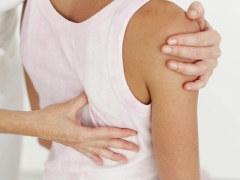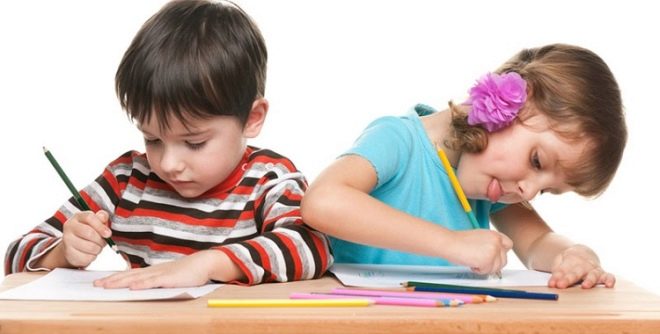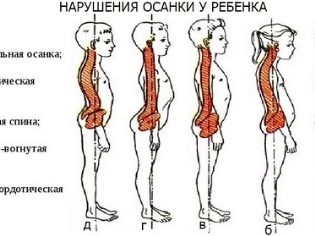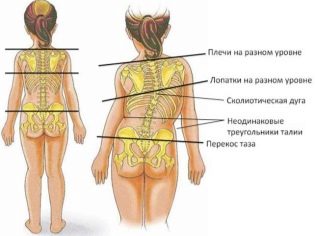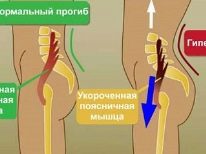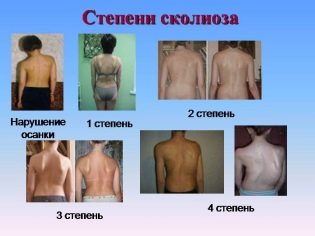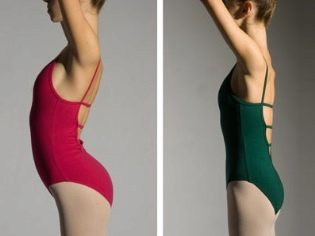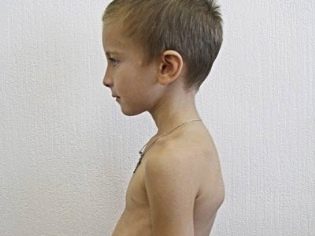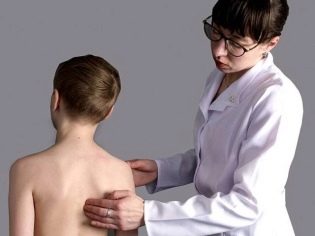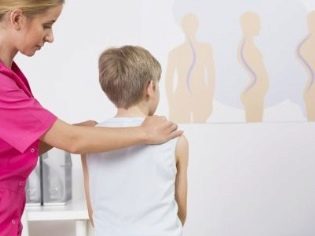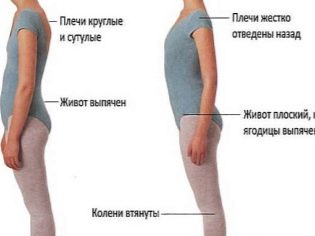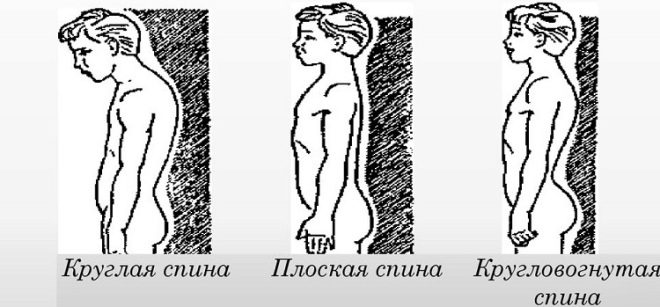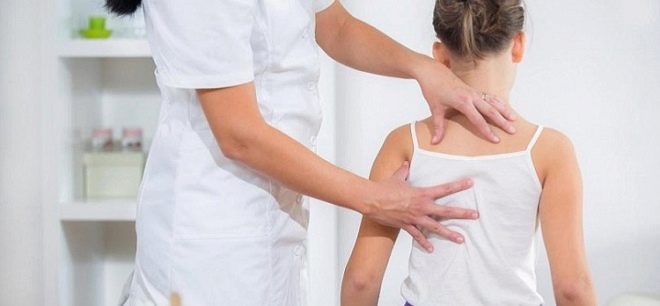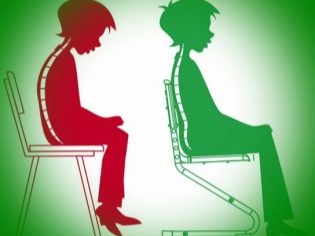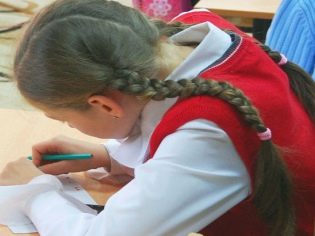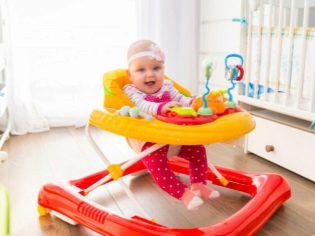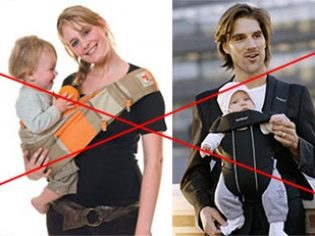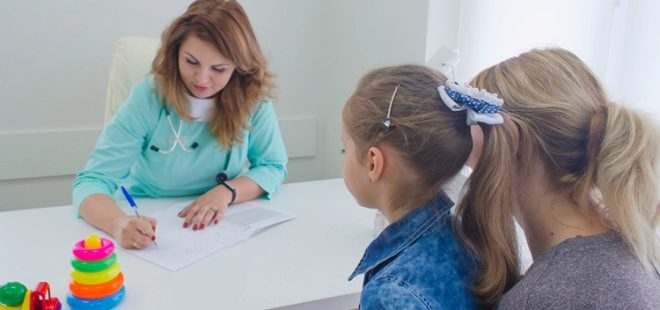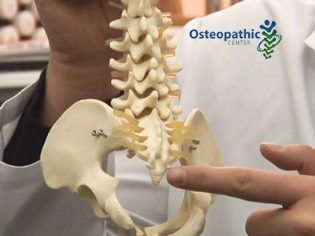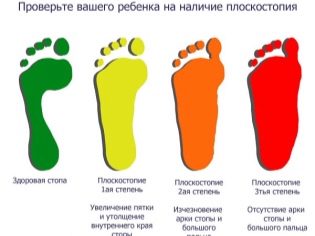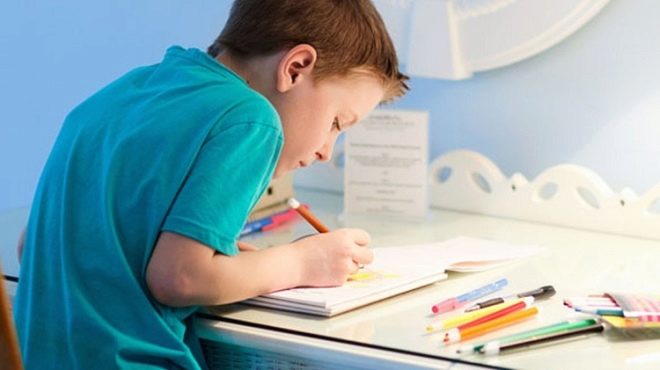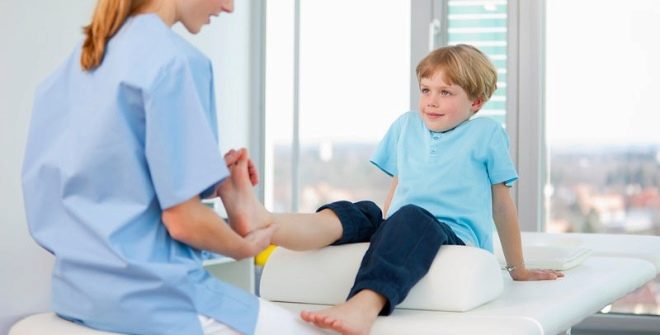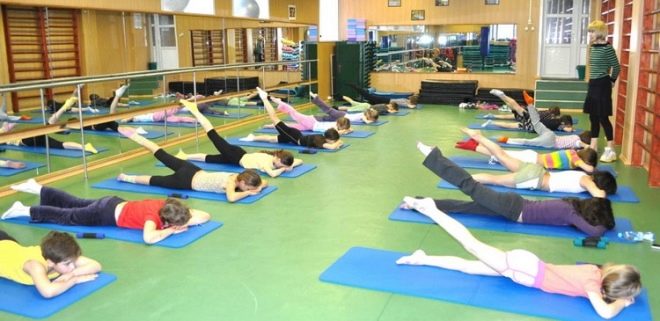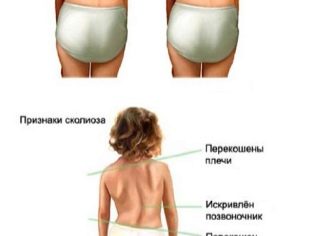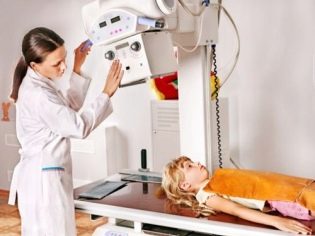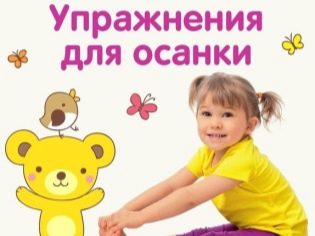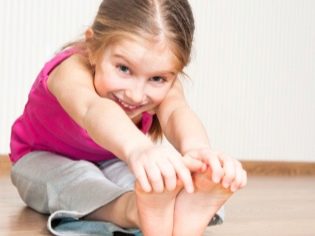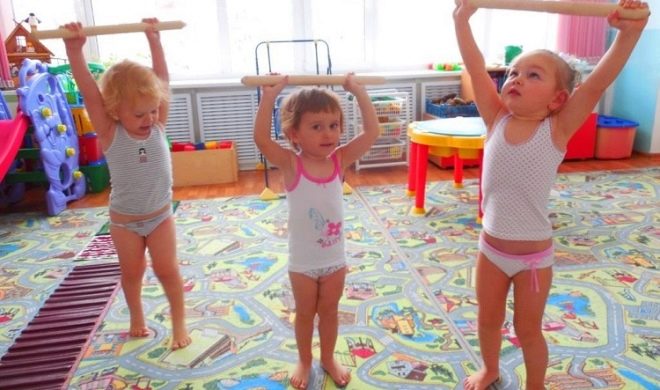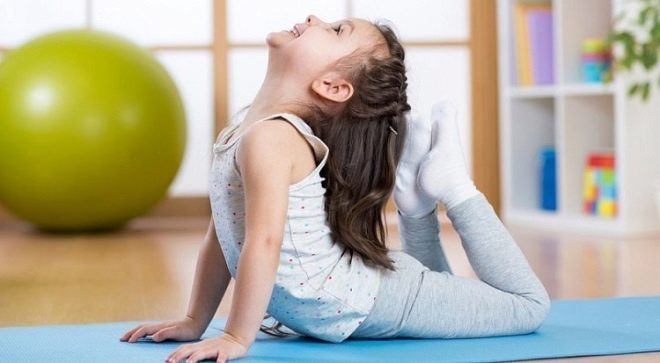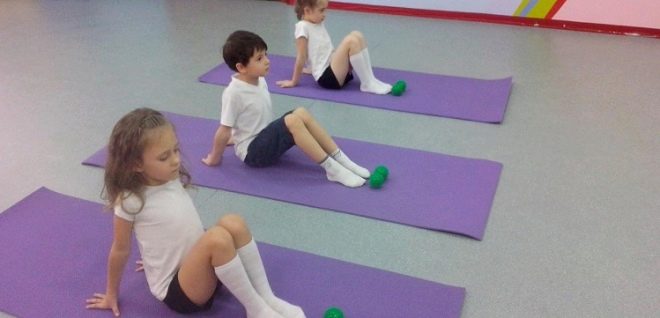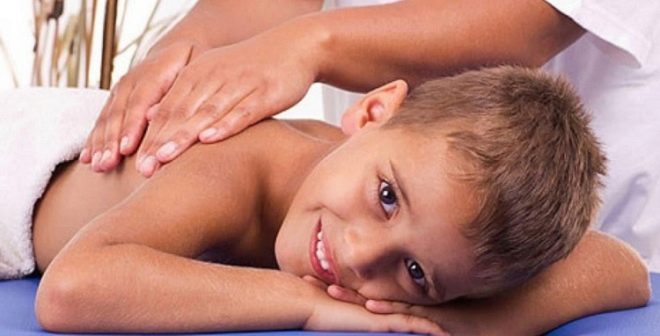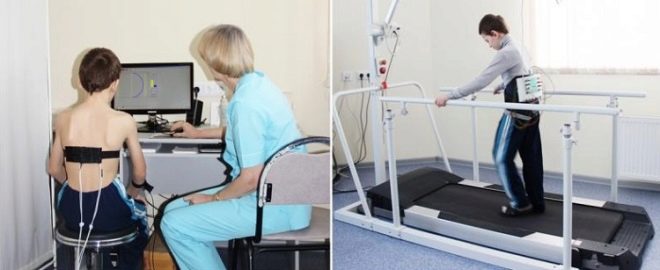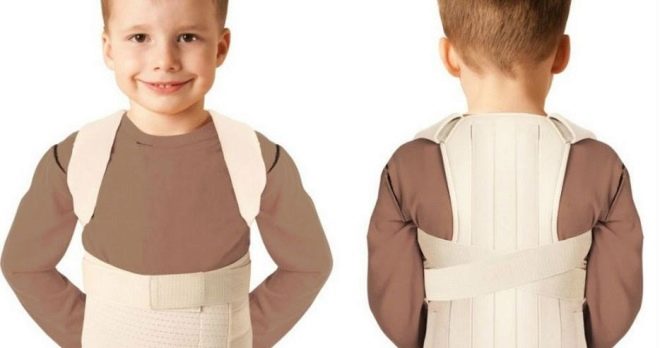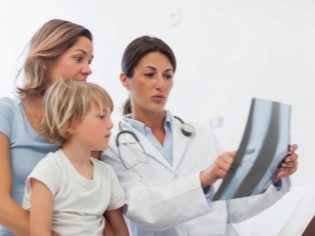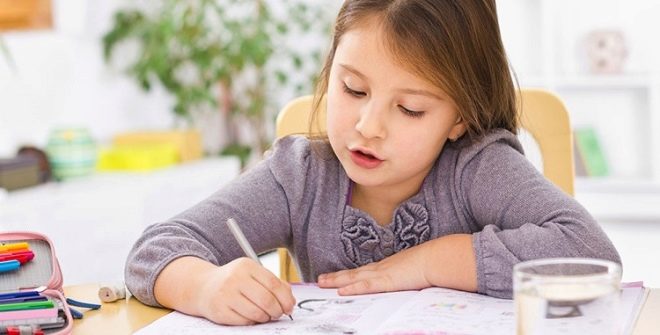Types of posture disorders in children and effective exercises for correction
Every third Russian child today has problems with posture. They may be more or less pronounced, accompanied by additional symptoms or flow almost unnoticed, but they are all quite dangerous and need to be corrected. In this article we will talk about what types of posture disorders exist and what correction will be most effective.
What it is?
Violations of posture are any changes in the position of the spine relative to the physiological norm. The spine can be deformed both in the frontal plane and in the sagittal one. The frontal plane is considered to be the rear view, and the sagittal is the side view. There are both violations in a separate plane, and combined disorders, the pathological signs of which are found in two planes at once.
When the vertebrae are in an unnatural position, a great force is imposed on them and on the muscles and ligaments, which are required to keep the spine in a stable upright position. To maintain the necessary balance, the muscles are in constant tension, which leads to pain, discomfort.
Incorrect posture is not considered an independent disease, it is only a pathological condition that needs correction, correction. In most cases, the problem is reparable.
If we ignore the first changes in the state of the musculoskeletal system, this can cause a variety of unpleasant consequences - the occurrence of irreversible deformities, displacement and compression of the internal organs, the violation of their functions.
A prolonged and neglected spinal problem increases the likelihood of spinal cord injuries, fractures, displacements, spinal hernias, etc. Statistics of the Ministry of Health, relevant at the beginning of 2018, states that different types of poor posture occur in approximately 2% of young children.
At preschool age, up to 17% of children suffer from them, on average at school age the number of such children rises to 33%, and at senior school age - up to 65%. This suggests that during the growth of bone tissue deformation tends to burden, if time does not carry out the correction.
Kinds
Since violations of posture can be observed in two planes, they are also classified according to this type. For frontal violations include scoliosis and scoliotic posture.
The list of sagittal deformations is much wider. These include:
- flat back (a condition in which all the vertebrae are smoothed);
- lumbar lordosis (pathological curvature of the spine in the lumbar region);
- cervical lordosis (bending of the cervical region);
- thoracic kyphosis (concave back);
- round back (combination of enlarged thoracic kyphosis with smoothing of lumbar lordosis);
- slouch;
- kypolordotic posture (increase in all the bends of the spine).
Any type of poor posture has several degrees of severity.
- At the first, the disturbances are usually initial and are easily amenable to simple correction.
- The second degree, as a rule, requires a more lengthy and painstaking approach to treatment, but in most cases it is also possible to cope with the help of conservative methods.
- The third degree of impairment is more serious, it is not always subject to conservative treatment, sometimes surgical methods are required.
- The fourth degree very often requires not only the operation, but also the establishment of the child’s disability status.
In children under 10 years of age, disturbances of grade 1–2 are the most common; on average, schoolchildren, and in teenagers, disorders of degree 2–3 are more common. According to doctors, this is due to the fact that an earlier diagnosis was not made at an earlier age, so a mild degree of impairment went unnoticed.
Let's look at the most common types of deformations.
Scoliotic posture
Such a violation differs from scoliosis in that there is no deformity in the pelvic region. Most often, the curvature occurs only in one section of the spinal column and only in one plane - the frontal one. Visually, the child may experience a slight shoulder asymmetry - one higher than the other. In scoliotic posture, the changes are visible mainly only in the vertical position of the body. When the child is lying, his spine is even, the curvature is not visible.
A small degree of scoliotic posture does not, in fact, require treatment, it is often enough to focus the child’s attention on the need to keep the backrest straight and also hold classes on the horizontal bar (vis). The third degree of such posture corresponds to the initial stages of scoliosis and needs treatment.
Kyphotic posture
By kyphosis in medicine, it is customary to understand the curvature in the thoracic spine. Kyphotic posture is a condition usually preceding the kyphosis as such. At the same time, the child tilts his head too much forward, the shoulders are also lowered forward, the shoulder blades stick out like wings, which gives the back a rounded shape.
Violation of posture for this type necessarily needs correction. If anxiety symptoms are ignored, an independent disease develops, for example, positional kyphosis. The posture disorder described above is its most initial stage.
The danger of this type of deformity is obvious - the rib cage bends inward, the lungs and heart are affected, and the hump can begin to grow. Osteochondrosis gradually joins.
Round back
Thoracic kyphosis (deflection inside the chest) in this violation is very pronounced, but the bend in the lumbar region, characteristic of all people, is almost absent. Looks like a back like a rounded, slightly hunchbacked. But outwardly unsightly appearance - this is half the trouble, because this position of the spine is extremely unstable. Because of the need to maintain balance, the child begins to walk on half-bent legs, which tenfold increases the load on the knee joints.
Even 20–30 years ago, this type of violation occurred infrequently in childhood. Now, when children spend more time at home, at the computer, move less, it is this pathology of the spine that has taken the leading position and is almost “equal” with scoliosis.
Round back
With this pathology, all the bends of the spinal column are smoothed out, which are caused by nature and are necessary for moving in space on their own two. Therefore, in children with a round-bent back, the gait changes dramatically - in order to maintain balance, they have to place a center of gravity on the knee joints, which in adolescence leads to knee injuries, severe changes in the structure of the knee joint, as well as its premature wear.
The shoulders of a child with such a curved back are raised and pulled out slightly forward, the shoulder blades stick out, the belly and buttocks droop, and when walking, his head is always slightly ahead of the body. Depending on the degree of poor posture, treatment is prescribed, which, by the way, is quite effective.
Flat back
So called the violation of the state of the spine, in which the vertebrae more resemble a straight line - all bends are excessively smoothed and reduced.Quite often, such a back is observed in children who are lagging behind in physical development and in those who grow too fast. In the first case, the muscular frame of the back is weak, and in the second, it does not keep pace with the growth of bone tissue.
The danger of this incorrect posture lies in the constant risk of injury and microtrauma to the vertebrae and the spinal cord, since natural depreciation, even during normal walking, is significantly reduced. Such children often complain of headaches, nausea, this is due to the occurring microscopic trauma of the vertebrae.
This type of pathological posture is considered one of the most dangerous; with it, any accompanying deviations in the state of the spine become intense and proceed very quickly, whether it is scoliosis or osteochondrosis of one of the parts of the ridge. Treatment is needed immediately.
There are other varieties, for example, a flat-bent back, the so-called "sluggish posture", but they are less common. In addition, there are congenital deformities of the ridge associated with such illnesses, such as myelodysplasia of the lumbosacral spine, the presence of additional vertebrae or the absence of some of them. Some forms of violation of posture are hereditary - a hunched dad, a hunched mom rarely bring up a slim, like a cypress, child. In most cases, the child also slouches.
Curvatures are traumatic and post-traumatic, arising after a spinal cord and muscle injury, and pathological. Under the pathological impaired posture, which became possible as a result of the reaction of the body (in particular, the vertebrae) to the presence of the disease, tumor.
The mechanism of any kind of disturbance is approximately the same: weakness of muscles that cannot hold fast growing bone tissue, attendant adverse factors from the outside and inside, deformations, which are becoming more and more difficult to keep weak muscles. It turns out a vicious circle, interrupted by doctors, parents and teachers, because most cases of anomalies respond well to correction.
The reasons
As already mentioned, the causes of spinal deformities can be both congenital and acquired. The second - prevail. Even during the development of the fetus in the womb, it may form irregular vertebrae, for example, wedge-shaped. Congenital causes may lie in myotonia, connective tissue dysplasia.
Some birth injuries can also affect the back of the child in the future - dislocation of the hip, torticollis, subluxation of the first cervical vertebra during labor.
Acquired forms of impaired posture most often suffer from slender children of asthenic body type (narrow chest, sloping shoulders, long limbs, narrow pelvis). But the thing, as you understand, is not in the constitution, but in the development of the child and the external factors that affect his posture.
The most common causes of the development of disorders in the state of the spine are:
- poor and irregular nutrition, calcium and vitamin D deficiency;
- low physical activity, lack of mobility;
- wrong landing at the table;
- long sitting in the wrong posture in front of a computer monitor or TV;
- carrying a satchel or bag in the same hand;
- low chair and high table or vice versa;
- insufficient coverage of the workplace of the child, where he writes, reads, draws;
- habit to read lying down.
At a very early age, parents themselves sometimes create the prerequisites for the development of a child’s postural disorders. So, pediatricians believe that to a large extent, the deformation of the ridge is facilitated by the wearing of a baby on the same hand, its early setting into verticalizing devices (jumpers and walkers), on the legs. Subsequently, mothers do not attach importance to the fact that they lead the child to walk all the time at the same pen.All this, repeating day by day, forms persistent deformations of the ridge.
There are a number of diseases and conditions that also contribute to the subsequent development of the curvature and smoothing of the vertebrae. These include:
- rickets;
- polio;
- tuberculosis;
- vertebral fractures, including compression;
- osteomyelitis;
- valgus deformity of the feet;
- flat feet;
- shortening one of the lower limbs.
Often a violation of posture develops in children who have poor eyesight or hearing poorly. In order to consider or hear something, they often have to take unnatural postures, which are gradually “fixed” at the level of muscle memory.
Symptoms and signs
Signs of poor posture in a child are not always easy to see with the naked eye at an early stage. Usually, parents begin to pay attention to this already when the clinical picture becomes evident. This fact is a good reason to look at your child more closely. Evaluate his posture should be when the child is standing. Only in the standing position do some forms of pathological changes appear, which will be completely unobvious if the baby is sitting or lying down.
Stoop is determined most easily. With her, the child's head moves forward somewhat, the shoulders are also directed forward, like a person who embraces himself by the shoulders. Buttocks look flat. At the back, you can pay attention to the protruding shoulder blades, especially prominent protruding lower edge.
Kyphotic posture is manifested by displacement of the head forward and somewhat downward, strong protrusion of the shoulder blades, as well as a strong reversal of the shoulders forward. The rib cage looks like it has sunk, which makes it feel like a vertebra sticks out in the neck. A child walks on bent legs. The muscle tone of all muscle groups is noticeably reduced, this is noticeable in the state of the press: even in thin children, the tummy is somewhat “hanging down”.
Such symptoms are characteristic of many types of violation of the state of the ridge in the thoracic and lumbar spine, and therefore it is very difficult to distinguish the kyphotic posture from the kypolordotic one by yourself — only doctors can do it on the basis of X-ray data. But accurate diagnosis from parents is not required. In fact, it is only important to pay attention to the basic deviations and in time, without delay, to contact the orthopedic surgeon, who will establish the type and type of pathology and give specific recommendations.
Suspicion of asymmetrical posture should creep in if the child is in a standing position with arms extended along the seams with different heights of shoulders, nipples and shoulder blades. The difference may be small, but it can not be ignored.
Since any curvature in the spine causes excessive tension in the muscles and ligaments, it is often the child who develops pain syndrome. True, he comes very gradually, and even the child itself for a long time can not pay attention to the pain. Most often, aching back pain occurs after a long standing, the need to sit exactly in one place. The child may not complain, but adults should definitely check with him if there is pain, if they noticed that the child slouches during drawing or writing, if in the process of reading often changes body position.
Poor posture, which has already caused complications in the work of the internal organs, is often accompanied by symptoms typical of certain pathologies on the part of these organs: with a decrease in the chest volume, it is more difficult for a child to take a deep breath, there is often a feeling of lack of air, and headaches general hypoxia.
Oxygen starvation due to reduced mobility of the chest usually leads to a stooped back, hollow and flat chest and other deformities in the thoracic spine.Strong and frequent headaches often lead to deformities of the cervical region. Numbness of the limbs, frequent diseases of the urinary system lead to curvature in the lumbar spine.
Usually, children with impaired posture learn less well, they get tired faster, they have reduced attention and ability to memorize and concentrate on the important, they are more likely to have flu and ARVI, and they often have viral diseases with complications of the respiratory organs and heart. Often these children have lowered hemoglobin levels in the blood.
With the curvature and deformation in the lumbar region, the abdominal muscles are very weak, this causes the abdominal cavity to sag. The stomach and intestines are shifted and lowered somewhat. In this case, the child begins to suffer from frequent constipation and other digestive problems. Pathological changes of the cervical vertebrae and the vertebrae of the thoracic spine often lead to a decrease in vision.
The school program in physical education is much more difficult for children with incorrect posture, they do not want to engage in sports clubs not because of laziness or “other vocation”, but because they get tired faster, even active and active games in the yard are for them can be quite difficult due to the rapid deterioration of health.
Diagnostics
Parents can pay attention to possible violations on their own, but only a doctor can determine the exact appearance. To do this, you need to contact an orthopedic surgeon at a children's clinic or a more rare specialist in the Russian medical institutions - a spine (spine specialist).
The doctor at the first visit will conduct a visual examination. The child is stripped to his pants and T-shirts, put in a vertical position. It is important for the doctor to evaluate his posture when viewed from the back, side and front. In addition to all the above signs of pathological changes in posture, other diagnostic signs should open to the experienced doctor's eye: a shift of the processes of the spine from the central midline to either side, different outlines of the gluteal folds and popliteal cavities, and asymmetric rib arches. In doubtful cases, the doctor will use simple and understandable measurements: he will calculate the distance from the seventh cervical vertebra to the edge of the scapula, measure and compare the length of each leg.
Also, doctors use the so-called Adams test. The child is asked to bend forward with arms outstretched or lowered. This test allows the doctor to assess the condition of the bends of the spinal column, the mobility of individual vertebrae. But even an experienced doctor with such a visual examination can make a mistake in the conclusion. And because all the warning signs that he finds on the examination, he will write under the question mark and give direction to a more accurate diagnosis. It includes x-rays, MRI of the spine as a whole or a specific part of it, computed tomography, ultrasound of the cervical spine.
The obtained results will help determine the angles of curvature, see the presence or absence of torsion (torsion of the vertebrae), microtrauma of the vertebrae, if any, with an accuracy of a degree. Based on the obtained results, the doctor will be able to determine the tactics of treatment or correction of incorrect posture.
Treatment
Treatment of postural disorders is always complex. It includes several methods that allow you to correct the stoop, eliminate muscle clamps, tension. Bringing the muscular system back to normal helps the child's body rebuild and ensure the correct support to the spine, with the result that the load begins to be distributed correctly, the spine straightens.
The exact way to correct posture and strengthen muscles that are not working properly is determined by the doctor depending on what type of disturbance is present, to what extent the pathology exists at the moment.1-2 degrees of almost all types of posture disorders do not need surgery or medication, but will require great work from the whole family to achieve the desired result.
Grades 3 and 4 of the disorders are essentially indications for the use of surgical treatment methods, followed by a long period of recovery and rehabilitation. Let's consider how to correct a bearing in different cases.
Conservative methods
The most popular and deservedly loved by doctors are the four main methods of correcting posture: physical therapy, massage, physiotherapy and wearing special orthopedic devices. The best results can be achieved if you apply all four at the same time with strict adherence to the recommendations of the doctor.
Exercise therapy and gymnastics
LFK - therapeutic gymnastics, which is carried out in specialized offices of children's clinics. The task of the doctor is the development of certain muscle groups of a small patient who suffer the most, as well as the strengthening of all other muscle groups.
Exercises for each child are made on an individual basis, taking into account the changes that were found in his spine. If the posture is minor, then you can attend classes at the clinic 1-2 times, after which the doctor will give recommendations on homework and tell the parents about the program of classes.
After the course of exercise therapy, a mandatory break is made during which parents must show the child to the orthopedist or the vertebrologist to make sure that the treatment is beneficial, the violations do not progress. For complex forms of disorders and advanced stages, the whole course should be carried out, preferably under the supervision of a specialist, by daily visiting the exercise therapy room. It is possible to visit such a specialist in paid clinics, but in this case it is important to take an appointment with the attending physician, in which he indicates the specific type and nature of the violation.
Do not assume that occupations in the clinic or in a private clinic and all limited. Parents will have to do 1-2 times a day with their child special exercises at home. She should also be approved by the attending doctor, but her general principles are as follows: training should be directed to all muscle groups, especially to the muscles of the back and shoulder girdle. Effective exercises for correcting posture can be divided into several groups.
- General standing - these include torso torso forward and sideways, tilts with a gymnastic stick, with a fitball in their hands.
- Common sitting - performed on a hard chair with a solid back and include raising hands to the sides, lifting them up, including with a gymnastic stick and a gymnastic ball.
- Common lying - performed on a flat solid surface and include exercises to strengthen the press and shoulder girdle, also performed with a gymnastic stick and without it.
Such exercises are considered more specific, during which the child will knead and strengthen certain parts of the spine. This may include hanging on the arms on the crossbar or the wall of the Swedish, “corner” on the wall (raising the legs at right angles to the body in a state of hanging, with a back against the wall).
Not only a horizontal bar and a gymnastic stick, but also a fitball will be useful for parents. Simple rolling on it on the stomach and back are useful for babies at 6-8 months with a tendency to curvature of the spine, and a slouching teenager.
Swimming is useful for strengthening the muscles of the back, and it is recommended that you write down a child with a broken posture. Some clinics today make up a complex of exercise therapy in such a way that it will necessarily include aqua aerobics exercises for back correction.
If there are no indications for observance of rest, then the child should move as much as possible, this will allow to correct the violations faster and strengthen the back, spine and muscular corset. True, parents need to remember well that there is no need to wait for a quick result, it will take several months or even more than a year to work.
Children with impaired posture is undesirable to make sharp jumps, practice on the trampoline, dive into the water ahead of your head from the tower. You should also avoid traumatic sports in which the fall - the usual thing, such as rugby, hockey, wrestling. Such exercises can provoke micro fractures and even completely spinal macrofractures in a weakened and damaged area.
While working with the child at home, remember that the duration of the exercise for correcting the posture should be increased gradually, starting with 2-3 minutes for one exercise and ending with 10-minute approaches. The duration of the occupation itself should also increase gradually, as well as the load on the body. Only in this case it will be possible to achieve a soft and stable correction.
Massage
With minor deviations of posture from the norm, it is recommended to carry out a general strengthening massage based on warming up, rubbing and kneading the muscles of the back and shoulder girdle. For more complex disorders, the doctor will recommend a manual or orthopedic massage, which is carried out only in clinics and massage rooms.
To correct the posture, massage is done by courses, the duration of each is established by the orthopedist. There is a break between courses. Even home massage should be done intermittently - the most common scheme looks like this: 10 days of massage daily - three weeks break.
Formation of a correct posture is possible only by massage effect. It is necessary to combine massage with medical gymnastics, swimming, as well as other recommended methods. In most cases, parents do not require large financial expenditures, because the methods of massage that strengthens the back are quite simple and do not require mandatory performance by specialists. In general, they are well known to all mothers: these are the very “Rails-sleepers” from our childhood, only each element needs to be performed for a longer time than it was meant by a joke.
Physiotherapy
The most popular methods include magnetotherapy and electrical stimulation of the muscles and ligaments of the back. Such sessions are conducted on the basis of a physiotherapy room in the clinic as prescribed by the attending physician. Both of these methods allow you to quickly achieve a state of muscle in which they will more reliably and anatomically correctly support the spinal column.
The treatment is carried out under the supervision of a physiotherapist, it has a course character, with uncomplicated forms of postural disorders it is enough to visit the procedures 1-2 times a year.
Orthopedic appliances
Teaching a child to keep his posture is quite difficult, especially if he has already formed the habits of sitting incorrectly and there are some violations. To help parents can special orthopedic devices.
Recliners for children are elastic loops, which, like the straps, are worn on the shoulders and converge around the shoulder blades. They do not allow the child to stoop, keeping his back in the correct position. There are reclinators with a sound signal that sounds every time a child breaks the landing.
Semi-rigid and rigid chest and thoracolumbar corsets are shown if the child does not have initial, but rather serious postural disorders. Such products are purchased in orthopedic salons with mandatory fitting and written prescription of the attending physician.
The latch of the back of the reclinator type can be purchased without an appointment, but in this case, you must first consult a doctor, because all orthopedic products have a lot of contraindications.
Other methods
Among other methods of complex treatment of disorders of posture can be noted a set of Pilates exercises, as well as mud and water therapy. If you have the opportunity to buy a ticket to a sanatorium specializing in diseases of the back and musculoskeletal system, you should not refuse this possibility.
Surgical methods
Surgical intervention for posture correction is rarely used. Only in those cases when the posture is disturbed due to a tumor or a vertebral injury that cannot be eliminated by other means.
If the deformities are progressing rapidly, one of the operational methods of treatment can also be considered, provided that the child is already 13-14 years old. Younger children surgery is carried out only for health reasons.
Surgeons have a variety of methods for solving a problem, from replacing a ruptured vertebra to fixative transplants. Successfully applied high-tech operation - vertebroplasty. Certain ligaments and muscles are also sutured and corrected.
At the end of the recovery period, treatment is prescribed using the four main conservative methods described above.
Forecasts
The chances of completely correcting the wrong posture of any type of violation, following the recommendations of the doctor and systematic activities with the child, amount to about 98%. Only in 1-2% of cases, according to the Ministry of Health, the violations are persistent or progressing, which requires a different approach to therapy.
How long the correction will last is difficult to answer. Some parents, according to numerous reviews, managed to level the back of the child for six months, someone for a year. In some cases, the correction may take one and a half or even two years. It all depends on what violations and in what stage were identified.
The earlier it is possible to detect pathological changes, the faster the treatment brings results.
Prevention
To avoid problems with posture, the child needs to provide favorable conditions:
- to create a comfortable workplace, you can purchase "growing" furniture with adjustable age and height;
- make the right lighting workplace;
- make sure that the diet of the child was enough foods with calcium content, food should be rich and regular;
- to harden the child, to encourage walking in the air, active and outdoor games on the street, being in the sunlight (within reasonable limits);
- to teach a child to control himself and his posture; for this, parents also need to keep their backs straight, because children often copy adults;
- engage in sports with the child, be sure to do morning exercises, even the simplest and fastest;
- not to rush things, not to put a small child too early on their feet and not to plant until he starts to crawl or crawl;
- make sure that the schoolboy's satchel is comfortable and orthopedic, with wide straps and a uniform distribution of weight over the entire area of the shoulder girdle.
The main thing is to closely monitor the child and his complaints. Even episodic headache complaints can be a symptom of an incipient spinal deformity. Do not leave them without attention.
The most dangerous age is from 1 to 3 years, and then from 5-6 to 14 years. It is during this period is the most intense growth of bone tissue. Any changes that have begun in the state of the spine can progress quite quickly at the very junior and middle school years. Pay special attention to prevention at this age.
Another important point of prevention are prophylactic vaccinations. Polio, for example, must be vaccinated. Tuberculin tests are also important, as transferred tuberculosis very often causes spinal deformities. Do not refuse vaccination. Also, do not neglect the mandatory medical examination. She often helps to identify violations of the musculoskeletal system at a very early stage.
Violations of posture is always easier to prevent than to correct. The child is growing up, and in adolescence it will become important for him how he looks. Curve back forms an inferiority complex in girls and boys, which prevents them from communicating and building relationships normally.
In the next video you are waiting for exercises in violation of posture and scoliosis in children.
